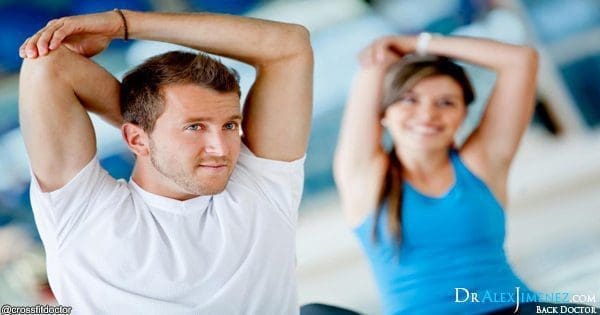The lower trapezius is a muscle which has been suggested to function ideally with the mechanics of the scapula. It has been acknowledged that improper mobilization of the scapula, also referred to as scapula dyskinesis, during overhead activities may lead athletes to experience sports injuries in the form of impingement, subacromial bursitis and instability. Due to its essential role in scapula function and subsequent athletic shoulder pain, the lower trapezius has become a topic of interest regarding both its activation ratios against the other trapezius as well as its timing during movement.
Table of Contents
Anatomy of the Lower Trapezius
Throughout the years, only a small amount of research has been conducted to study the anatomy of the lower trapezius. However, there is plenty of research regarding the role of the lower trapezius in scapula function and the association between lower trapezius dysfunction and shoulder pain. A notable study conducted in 1994 on the anatomy of the lower trapezius found that the lower trapezius begins on the spine and lengthens from the T2 to T12 vertebrae, inserting onto the spine of the scapula from the acromion process to its root. According to the anatomy study, the lower trapezius closely follows the middle trapezius which attaches to the C7 and T1 vertebrae, also attaching to the spine of the scapula. The lower trapezius is a multipennate muscle which is innervated by the accessory nerve, or the eleventh cranial nerve, and the ventral rami of the third and fourth cervical nerves along the cervical plexus.
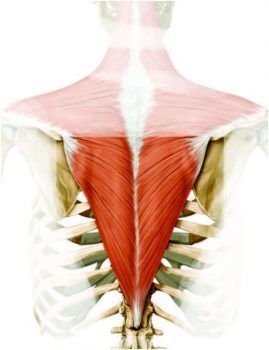
The Function of the Lower Trapezius
The scapula is the foundation of all upper limb kinetic chain movements. To function effectively, it must have enough flexibility and mobility to achieve the necessary positions to allow the humerus to move smoothly, without impingement. It also needs to remain strong and stable during upper limb movements, specifically overhead sports activities to provide the proper transmission of force from the body to the hand, most important in athletic activities such as swimming, tennis and throwing sports.
The lower trapezius is a muscle that plays an essential role during scapula movement and positioning as well as dynamic scapula stability. The upward rotation, posterior tilt, and external rotation movements of the scapula function to increase the width of the subacromial space during humeral elevation. Nonetheless, a lack of proper scapula function, or scapula dyskinesis, can increase the adaptation of the humeral head, altering the position and motion of the scapula, often leading to injury.
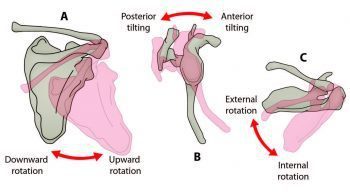
The lower trapezius is one of the various muscles of the body that function during upward rotation, posterior tilt and external rotation of the scapula along with the middle trapezius and serratus anterior. The role the lower trapezius plays in scapula function cannot be discussed on its own because it works together with the other muscles that surround it to create a force couple at the scapula. The contribution of other competing factors in scapula dysfunction including pectoralis minor tightness, posterior shoulder capsule tightness and thoracic spine stiffness should also be considered when diagnosing scapula complications.
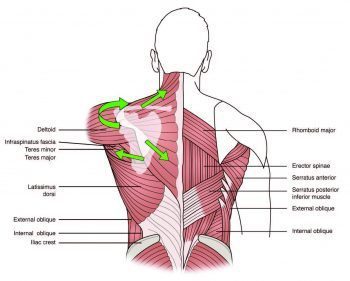
The exact role of the trapezius in shoulder mobility has been previously researched. The researchers of the study first calculated the anatomical lines of action of the fibres of the trapezius and, considering these lines of action together with the changing scapulothoracic axis of rotation, they found that the middle and lower trapezius are perfectly suited to stabilize the scapula and its external rotation. Because of the immediate center of rotation of the scapula on the thorax, it is designed to move from the root of the spine towards the AC joint along the line of trapezius insertion.
The lower trapezius is the only muscle of the trapezius that can considerably rotate the scapula upwards. Although, its length between each joint and the force acting on it will change across the range of motion to elevate the arm. As the scapula moves through upward rotation, a movement that shortens the lower trapezius, it also protracts and elevates, movements that elongate the lower trapezius. As a matter of fact, the actual change in muscle fibre length can remain unchanged, making the lower trapezius contraction almost exclusively isometric.
The lower trapezius takes part in several essential functions as follows:
First, the scapula stabilizes the shoulder as it moves into abduction. The initial movement and inertia of the humerus in abduction causes a drag effect on the scapula and pulls it into a downward rotation position. The lower trapezius functions as a feedforward muscle before its abduction to contract and hold the scapula stable in order to counteract the downward rotation drag effect. As a result, it counteracts the scapula at the start of abduction. During the first 30 degrees of abduction, the scapula remains immobile but it is held steady by the lower trapezius.
Also, during progressive shoulder abduction, approximately from 30 degrees to 120 degrees, the lower trapezius functions to establish the upward rotation of the scapula together with the serratus anterior. The lower trapezius muscle stabilizes the scapula against the protraction effect produced by the serratus anterior.
Then, at the uppermost levels of abduction, about 120+ degrees, it works to also create a posterior tilt of the scapula. It neutralizes the elevation effect of the upper trapezius and levator scapulae during the end of range abduction.
Moreover, while the upper trapezius doesn’t seem to have a line of action for being an upward rotator in healthy individuals, the lower trapezius helps to produce scapulothoracic upward rotation. Further evidence has demonstrated that the lower trapezius is the primary upward rotator of the scapula along with serratus anterior.
Furthermore, the lower trapezius also retracts and pushes down the scapula during horizontal pulling movements, such as rowing, and works with other scapular retractors in postural positions to counteract the effect of scapular protraction when sitting.
And last but not least, the activity of the lower trapezius has been found to be relatively low during scapular abduction and flexion angles of less than 90 degrees with rapid increases during 90 to 180 degrees. This emphasizes the increasing role it plays in upward rotation and posterior tilt as the shoulder abducts above 90 degrees.
Shoulder Injuries and Conditions
Research studies have evaluated the cause and effect relationship between lower trapezius complications and consecutive shoulder pain. Theories have before mentioned that the muscle may be dysfunctional, leading to poor scapula movement and symptoms of pain. Other theories explain that pathology in the joint may develop first, inhibiting the lower trapezius. Regardless of its cause or effect, the presence of a dysfunctional lower trapezius demonstrates that the muscle will often require medical interventions to improve its function.
Numerous studies have been conducted on the role the periscapular muscles play in scapula function/dysfunction and their associated symptoms. It has been recognized that the scapula muscles, including the lower trapezius, functions to enhance the rotator cuff’s ability to perform properly. These create a resistant scapula that allows the rotator cuff to function more efficiently.
Various findings have been recorded below, relating to lower trapezius dysfunction and pain syndromes:
Foremost, a lack of activity in the lower trapezius has been recognized along with overhead movements that cause impingement, often together with an excessive upper trapezius activation.
Also, structures often associated with secondary subacromial impingement are identified as low levels of serratus anterior and lower trapezius muscle activation which cause a distinction of the medial border and inferior angle of the scapula, along with its excessive internal rotation.
The strength of the lower trapezius also decreases among individuals with unilateral neck pain.
Then, considerably delayed middle and lower trapezius activation has been displayed in overhead athletes with shoulder impingement, in response to an unexpected drop of the arm from an abducted position. The lower trapezius is believed to react slower when compared to the upper trapezius, which may become overactive, leading to scapular elevation rather than upward rotation.
Researchers found a decrease in lower trapezius activity during isokinetic scapula protraction in 19 overhead athletes with subacromial impingement.
Additionally, the researchers reported that athletes with impingement complications have a significantly higher upper trapezius activation compared to healthy individuals, a considerable decrease in lower and middle trapezius activation and altered trapezius muscle balance.
Activity of the Lower Trapezius in Exercise
When an athlete has suffered damage or injury on the lower trapezius, there are several rehabilitation exercises the individual can follow. Literary conflict exists where some authors have argued about the proper treatment plans for injury. According to several sources, recovery for individuals with lower trapezius imbalances must be performed with reduced activation to avoid fatigue, approximately 20 to 40 percent of maximum voluntary contraction. Furthermore, high levels of activity may be associated to other scapular muscles, such as the upper trapezius and even the latissimus dorsi.
Other researchers argue that the exercises for the rehabilitation of the lower trapezius need to be performed in weight bearing and in kinetic chain patterns to fully resemble what the muscle does in gross kinetic chain function. They’ve noted that in average sports specific movements, early upper trapezius activity is normal, and thus, rehabilitation for athletes should encourage early upper trapezius activation.
Many studies acknowledge the significance of glenohumeral external rotation in activating greater lower trapezius activation. Exercises such as the scaption, robbery exercise, the lawn mower and the shoulder horizontal with external rotation, all draw out greater levels of lower trapezius activation. Some researchers state that the rotator cuff and scapular stabilizers function conjointly to maintain optimal length-tension relationships within the rotator cuff. They postulated that with shoulder external rotation, as the humeral attachment of the infraspinatus and posterior deltoid approximates the scapula, the muscle would lose optimal length-tension. Accordingly, if the scapula was to retract simultaneously to humeral external rotation, the medial scapula would distance itself from the humeral attachment, thus maintaining the length-tension relationship.
The position of arm elevation may also be crucial. Abduction angles around 130 degrees appear to obtain the greatest lower trapezius activation while minimizing the upper trapezius. A research study, for instance, determined that the position in which the individuals elevated the humerus above the head in line with the lower trapezius muscle fibres, activated the lower trapezius up to 97 percent MVIC, or market value of invested capital.
Scapular Resetting in the Neutral Position
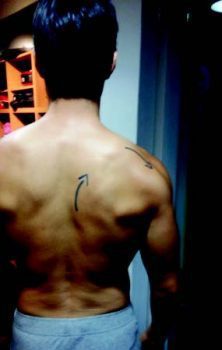
A healthcare professional can assess scapula muscle imbalances by evaluating the position of the scapula in a standing position. If the scapula appears to be downwardly rotated/ anterior tilted and protracted, an imbalance may exist in the pectoralis minor and the lower trapezius.
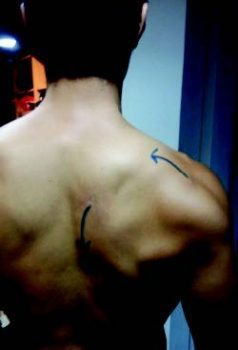
A relatively safe exercise known as an active scapula setting drill can be guided by a healthcare professional to gently activate posterior tilt, upwardly rotate and retract. Also, the individual can actively externally rotate their humerus gently. The healthcare specialist can palpate the lower trapezius for activation and this position can be held for 10 second holds. Resistance can then be added in the form of tubing to force the scapula into a more downward rotation.

Scapula Re-Setting in the Horizontal Plane
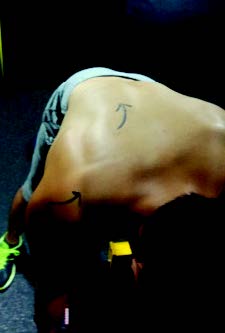
This is an exercise progression aimed to encourage the retraction and depression role of the lower trapezius. Weight is needed to create a drag effect on the scapula into protraction and elevation to create the necessary length-tension curve for the lower trapezius.
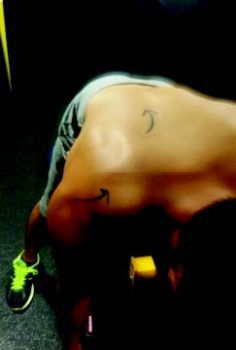
First, the individual is positioned in one hand supported prone, or one-arm row posture, with a 2.5kg weight for women or 5kg for men. The individual is encouraged to allow the scapula to ‘hang’. The healthcare professional then guides the appropriate movements of retraction and depression while the individual slightly externally rotates the humerus during the movement to keep the lift of the dumbbell only subtle. This position can be held for a 5 second contraction. Care must be taken to avoid excessive upper trapezius use, where the individual will lift the shoulder towards the ear, excessive latissimus dorsi use, where the arm will move slightly into extension and rhomboids use, where the muscles will bunch and the scapula will be seen to downwardly rotate.
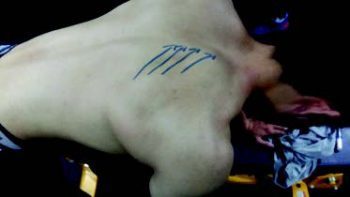
Scapula Setting in Elevated Plane
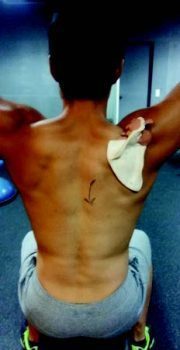
This is a further progression that is appropriate for those with minimal pain on shoulder elevation. If the individual is suffering current shoulder pain during elevation then this would be inappropriate.
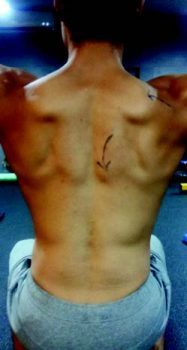
First, the client sits and holds a lat pulldown bar. The weight needs to be sufficient to create an elevation drag effect. Then, the individual sits back slightly so that the trunk angle is approximately 70-80°. This allows the humerus to follow the ‘scaption’ plane. Third, the individual is guided to gently retract and depress the scapula using the lower trapezius. Similar to the above exercise, they are encouraged to gently externally rotate the humerus. As the bar is a solid object, they are encouraged to simply and gently ‘bend the bar’. Again care must be taken to keep the movement subtle to avoid excessive latissimus dorsi and/or rhomboid activation.
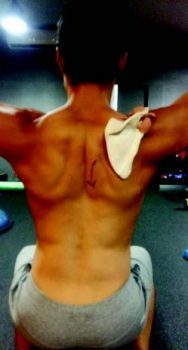
High Level Activation
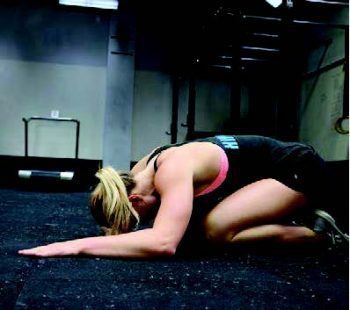
This is an exercise best suited to end stage rehabilitation or as a pre-rehab setting exercise prior to training. The individual will need a pain-free shoulder to perform this movement. First, the individual must slowly reach the hand along the floor to create scapula upward rotation.
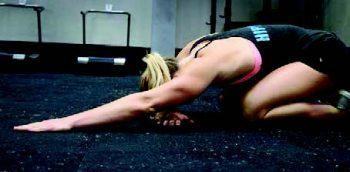
Now, the individual must slowly externally rotate the humerus.
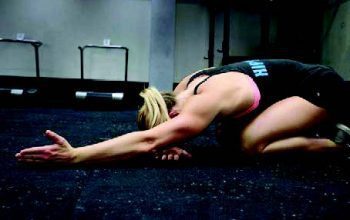
Finally, the individual should slowly lift the arm off the floor to encourage retraction and posterior tilt of the scapula. 5. Hold for 5 seconds and repeat.
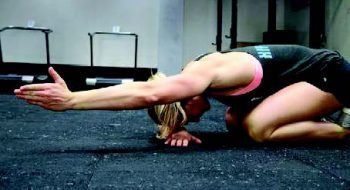
Shoulder Stretches
.video-container{position: relative; padding-bottom: 63%; padding-top: 35px; height: 0; overflow: hidden;}.video-container iframe{position: absolute; top:0; left: 0; width: 100%; height: 100%; border: none; max-width:100%!important;}
Furthermore, the individual may also perform a series of shoulder stretches, to strengthen the shoulder and the surrounding muscles of the neck, shoulder and back. It’s important to keep in mind to consult a healthcare professional before attempting any of the above exercises and stretches, to avoid further injury for the athlete.
For more information, please feel free to ask Dr. Jimenez or contact us at 915-850-0900 .
By Dr. Alex Jimenez
Post Disclaimer
Professional Scope of Practice *
The information on this blog site is not intended to replace a one-on-one relationship with a qualified healthcare professional or licensed physician and is not medical advice. We encourage you to make healthcare decisions based on your research and partnership with a qualified healthcare professional.
Blog Information & Scope Discussions
Welcome to El Paso's Premier Wellness and Injury Care Clinic & Wellness Blog, where Dr. Alex Jimenez, DC, FNP-C, a board-certified Family Practice Nurse Practitioner (FNP-BC) and Chiropractor (DC), presents insights on how our team is dedicated to holistic healing and personalized care. Our practice aligns with evidence-based treatment protocols inspired by integrative medicine principles, similar to those found on this site and our family practice-based chiromed.com site, focusing on restoring health naturally for patients of all ages.
Our areas of chiropractic practice include Wellness & Nutrition, Chronic Pain, Personal Injury, Auto Accident Care, Work Injuries, Back Injury, Low Back Pain, Neck Pain, Migraine Headaches, Sports Injuries, Severe Sciatica, Scoliosis, Complex Herniated Discs, Fibromyalgia, Chronic Pain, Complex Injuries, Stress Management, Functional Medicine Treatments, and in-scope care protocols.
Our information scope is limited to chiropractic, musculoskeletal, physical medicine, wellness, contributing etiological viscerosomatic disturbances within clinical presentations, associated somato-visceral reflex clinical dynamics, subluxation complexes, sensitive health issues, and functional medicine articles, topics, and discussions.
We provide and present clinical collaboration with specialists from various disciplines. Each specialist is governed by their professional scope of practice and their jurisdiction of licensure. We use functional health & wellness protocols to treat and support care for the injuries or disorders of the musculoskeletal system.
Our videos, posts, topics, subjects, and insights cover clinical matters and issues that relate to and directly or indirectly support our clinical scope of practice.*
Our office has made a reasonable effort to provide supportive citations and has identified relevant research studies that support our posts. We provide copies of supporting research studies available to regulatory boards and the public upon request.
We understand that we cover matters that require an additional explanation of how they may assist in a particular care plan or treatment protocol; therefore, to discuss the subject matter above further, please feel free to ask Dr. Alex Jimenez, DC, APRN, FNP-BC, or contact us at 915-850-0900.
We are here to help you and your family.
Blessings
Dr. Alex Jimenez DC, MSACP, APRN, FNP-BC*, CCST, IFMCP, CFMP, ATN
email: coach@elpasofunctionalmedicine.com
Licensed as a Doctor of Chiropractic (DC) in Texas & New Mexico*
Texas DC License # TX5807
New Mexico DC License # NM-DC2182
Licensed as a Registered Nurse (RN*) in Texas & Multistate
Texas RN License # 1191402
ANCC FNP-BC: Board Certified Nurse Practitioner*
Compact Status: Multi-State License: Authorized to Practice in 40 States*
Graduate with Honors: ICHS: MSN-FNP (Family Nurse Practitioner Program)
Degree Granted. Master's in Family Practice MSN Diploma (Cum Laude)
Dr. Alex Jimenez, DC, APRN, FNP-BC*, CFMP, IFMCP, ATN, CCST
My Digital Business Card


